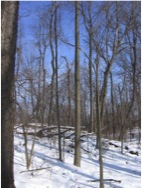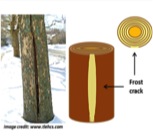 Purdue University - Extension - Forestry and Natural Resources
Purdue University - Extension - Forestry and Natural Resources
Got Nature? Blog
 “When it snows…
“When it snows…
and temperatures drop,
That’s when you’ll hear
The Snap, Crackle and Pop.”
Few things can compare to the peacefulness of walking in a forest filled with snow covered trees until you hear a snap, crackle or an explosive “POP” echoing through the woods. What on earth was that? If the noise is followed by a “whoosh,” it may be a limb that just broke and crashed to the ground. If it sounded like a gunshot but nobody is there, you may be listening to the sound of a frost crack forming on a tree.
What are frost cracks?
Nobody knows for sure. You may hear one happen, typically on a cold late winter morning after a warm spell. They sound like muffled to loud rifle shots. Typically, these cracks occur on the south side of the trunk between two and five feet up the tree (when measuring from the ground). With leaves on, water is pulled upwards from tree roots through the xylem vessels by the differences in water potential from the air to the soil and escapes through the leaves (the soil-plant-air continuum).
Water in the plant is under a negative water potential, or in common terms, under tension. In the winter, when deciduous trees have no leaves, the water pressure in the sap becomes positive. A flow occurs where water moves up in the xylem and cycles down in the phloem (food conducting cells). The mechanism of this winter flow in temperate trees is not well understood physiologically. The sap increases in simple soluble sugars as the cold weather begins and increases until midwinter to work like antifreeze, depressing the freezing point of water. This is why maple syrup can be tapped in late winter.
 Scientists are challenged to study the phenomena of frost cracks. They involve thousands of xylem vessels in a very narrow vertical line bursting all at once – as if a line of sap is too low in sugar concentration – and then freezes hard explosively bursting the vessels. After several growing seasons, most trees will heal over the crack, but callus growth makes them appear wider. Valuable timber logs can still be profitably harvested with frost cracks as millers can cut through them to minimize the defect.
Scientists are challenged to study the phenomena of frost cracks. They involve thousands of xylem vessels in a very narrow vertical line bursting all at once – as if a line of sap is too low in sugar concentration – and then freezes hard explosively bursting the vessels. After several growing seasons, most trees will heal over the crack, but callus growth makes them appear wider. Valuable timber logs can still be profitably harvested with frost cracks as millers can cut through them to minimize the defect.
Species with darker colored bark and thinner bark can be affected by frost cracks. Some genotype effects have been found in black walnuts at Purdue. Field conditions and topography that effect cold air movement can affect frost cracks. Most form on the southwestern section of the trunk, the area most affected by warming from sunlight during winter afternoons. Somehow, this conditioning sets up the tree when temperatures plummet to single digits (in Fahrenheit) or lower, especially after a warmer period.
So if you wander through the woods this winter, stop but don’t “drop” when you listen to the sounds of the trees.
“When the snow twinkles
and the skies are bare…
Temperatures drop
and a chill fills the air.
If you listen real close
and adjust your cap,
You just might hear
a tree go ‘Snap!’”
Resources
Bark Splitting on Trees, Cornell University
Video: How Do Trees Survive Winter? MinuteEarth
Winterize Your Trees, The Education Store
Shaneka Lawson, Adjunct Assistant Professor
Department of Forestry and Natural Resources
James McKenna, Operational Tree Breeder
Department of Forestry and Natural Resources

Recent Posts
- Report Spotted Lanternfly – Purdue Landscape Report
Posted: April 10, 2024 in Alert, Forestry, Invasive Insects, Plants, Wildlife, Woodlands - Declining Pines of the White Variety – Purdue Landscape Report
Posted: in Alert, Disease, Forestry, Plants, Wildlife, Woodlands - Are you seeing nests of our state endangered swan? – Wild Bulletin
Posted: April 9, 2024 in Alert, Forestry, How To, Wildlife - Cicadas in Spring! – Purdue Landscape Report
Posted: in Forestry, Plants, Safety, Wildlife - New Deer Impact Toolbox
Posted: April 7, 2024 in Forestry, Land Use, Plants, Publication, Safety, Wildlife, Woodlands - 2024-25 Fishing Guide now available – Wild Bulletin
Posted: April 4, 2024 in Alert, Aquaculture/Fish, Aquatic/Aquaculture Resources, How To, Ponds, Wildlife - Help Research Chronic Wasting Disease – Wild Bulletin
Posted: April 3, 2024 in Disease, Forestry, How To, Safety, Wildlife, Woodlands - Indiana Reptiles and Amphibians – IFWOA Webinar
Posted: April 1, 2024 in Forestry, How To, Webinar, Wildlife, Woodlands - Birding through the Seasons – IFWOA Webinar
Posted: in Forestry, How To, Webinar, Wildlife, Woodlands - Look Out for Invasive Carp in Your Bait Bucket – Wild Bulletin
Posted: March 31, 2024 in Alert, Aquaculture/Fish, Aquatic/Aquaculture Resources, Invasive Animal Species, Wildlife
Archives
Categories
- Alert
- Aquaculture/Fish
- Aquatic/Aquaculture Resources
- Ask the Expert
- Christmas Trees
- Community Development
- Disease
- Drought
- Forestry
- Forests and Street Trees
- Gardening
- Got Nature for Kids
- Great Lakes
- How To
- Invasive Animal Species
- Invasive Insects
- Invasive Plant Species
- Land Use
- Natural Resource Planning
- Nature of Teaching
- Plants
- Podcasts
- Ponds
- Publication
- Safety
- Timber Marketing
- Uncategorized
- Urban Forestry
- Webinar
- Wildlife
- Wood Products/Manufacturing
- Woodland Management Moment
- Woodlands